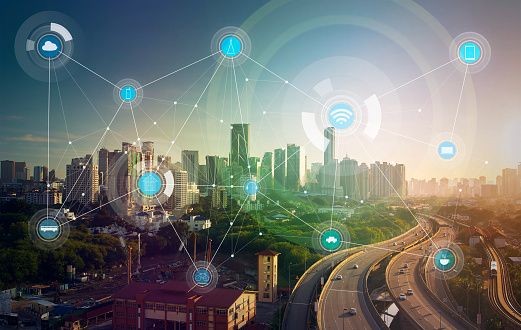Smart Buildings all Over the World
What is a smart building?
Smart building is defined as “one which provides a productive and cost-effective environment through optimization of 4 basic factors: structure, systems, services and management, and the interrelationship among them.” According to this preliminary definition, a smart building is one which optimally matches its four elements to the customers’ desires with an emphasis on the technology that makes the interrelationship among the elements possible.
As smart buildings began to take hold around the world during the late eighties and nineties, many competing definitions were recommended. In Europe, the European intelligent buildings organization coined a brand new definition declaring that a smart building “creates an environment which maximizes the effectiveness of the building’s occupants, and at the same time enabling efficient management of sources with minimum lifetime costs of hardware and facilities”, tilting the spotlight towards the occupant’s needs to be served by technology. In Asia, the definitions focused on the role of technology for automation and control of building functions.
Smart Building Benefits:
Smart buildings integrate technology and the internet to provide solutions to the old age troubles of overspending and inefficiency in building construction and use. Within a smart building all the systems are connected, from conditioning to the security and lights. With the usage of sensors, which include footfall counters and thermal imaging, actionable data is gathered on how the building is being used to enable it to perform better.
Five of the key advantages of smart buildings are:
- Reducing energy consumption
Figures vary depending on systems and buildings, however, you may lessen the electricity consumption in a building by means of around 5% – 35% with using smart technology. This interprets into vast monetary financial savings, as well as a much more efficient and effective approach to meet green goals.
- Improving building efficiency
Unobtrusive cameras and thermal sensors provide data-protection-safe information about how the building is being used. This enables smart systems to make adjustments about where heat and light are required, for example, and on the use of infrastructure such as air conditioning.
Sensors also help to identify overused and underused areas in the building, providing the opportunity to optimise space utilisation, which in turn can facilitate growth.
- Predictive maintenance
Maintenance costs may be substantial while treated manually. However, without building preservation tools requires far more frequent replacement, which takes chunks out of budgets. Smart buildings enable simpler maintenance.
Sensors can detect building performance and activate maintenance procedures before an alert is triggered.
- Getting more from the building occupants
Smart buildings were specially designed to deliver a more comfortable experience for their occupants. They can raise standards and ensure that health and safety considerations are being met, to make it certain that this is applied in a cost efficient way. Smart buildings make human beings more productive by continually monitoring building use and adjusting systems to ensure that occupants have the facilities they need.
- More efficient planning and use of resources
The data generated by a smart building provides key insight that can be fed into planning and use of resources. Therefore, there is no longer a need to rely on guesswork when it comes to resource management as this can be informed by real-time, genuine intelligence.
In this article, we will present some of the smart buildings in the world:
- The Gates’ Home, Washington
The Gates’ Home is one of the smartest smart buildings in the world. The home is programmed to remember preferences and individual choices. It is integrated with a hi-tech sensor system that changes the temperature and alters the lighting system of the entire house according to the preferences of the visitors or family. It is an earth sheltered house that uses natural surroundings to reduce the loss of heat. Every room in the house is designed and programmed to change the temperature and light according to the individual’s choices.
- Al Bahr Towers, Abu Dhabi
Al Bahr Towers designed by Aedas was crowned as the ‘Best Overall Project in the Middle East. Al Bahr Towers which feature the world’s largest computerised dynamic façade. The design of Al Bahr Towers responds to the fundamental issues affecting the corporate standards of a fully glazed building in a searingly hot climate. It solves this challenge with the integration of a façade based on the Islamic ‘mashrabiya’, a lattice screen used to diffuse sunlight while keeping buildings cool, without blocking sunlight or views. Uniquely, its honeycomb structure opens and closes in response to the movement of the sun, reducing solar gain by up to 50%, whilst simultaneously improving natural light inside the towers.
- Siemens HQ, Masdar City
Masdar City is located in United Arab Emirates, which aims to be the world’s first sustainable and self-sufficient city, located in the desert of Abu Dhabi and under construction since 2006 (expected to fully open its doors in 2020). Despite the harsh location, it achieves a 63% savings in energy consumption and 52% in water consumption compared to a standard Abu Dhabi office building. It was conceived as a box inside a box. The inner part is a completely hermetic facade, designed to reduce the thermal conductivity; and around, a lightweight aluminum coating that minimizes the sun while maximizing light and aluminum fins that move to best suit the sun’s position.
- The Edge, Amsterdam
The Edge Building is located in Amsterdam, The Netherlands, it is considered the most intelligent and greenest building in the world. According to the British rating agency, which gave it the highest sustainability score ever. Among its innovations is the fact that the building recognizes the tenants’ car and directs them to the most convenient available parking space. The building has charging stations for hybrid and electric cars and the cleaning is done by robots. In addition, the building has its own app that knows the preferences of the employees, like lighting and temperature, and adjusts them accordingly.
- The Crystal Building, London
The Crystal is a building on Royal Victoria Dock in east London which contains a permanent exhibition about sustainable development. It is owned and operated by Siemens. It is part of the Green Enterprise District policy that covers much of East London. The site is 18,000 square meters in size at the west end of the dock. Using solar power and ground source heat pumps to generate its own energy, it has set a high benchmark for sustainability. The building is the first to achieve the highest sustainable building accolades from the world’s two leading accreditation bodies, LEED and BREEAM, Platinum and Outstanding respectively. It is considered the most sustainable building in London.
FSC Conference:
Smart Buildings is one of the “Future Smart Cities” conference topics. This conference will be held in Kuala Lumpur, Malaysia from 15 – 17 July 2019.
If you are interested in this field, Register now


